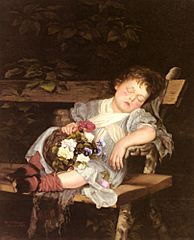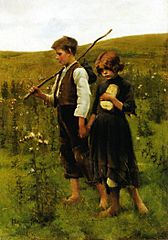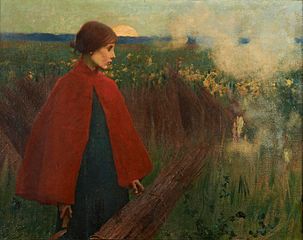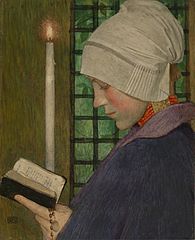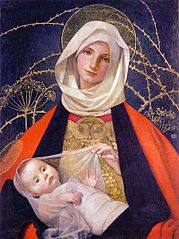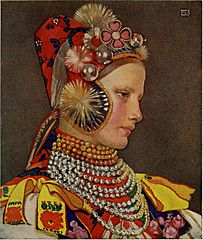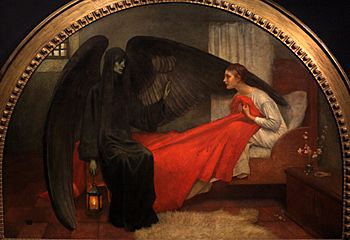Marianne Stokes facts for kids
Quick facts for kids
Marianne Stokes
|
|
|---|---|
 |
|
| Born |
Marianne Preindlsberger
1855 |
| Died | August 1927 |
| Known for | Painting |
| Spouse(s) | Adrian Scott Stokes (m. 1884) |
Marianne Stokes (born Preindlsberger; 1855–1927) was a talented painter from Austria. She moved to England after marrying Adrian Scott Stokes (1854–1935) in 1884. Adrian was also a landscape painter. They first met in a French town called Pont-Aven. Marianne Stokes was known as one of the most important women artists in Victorian England.
Her Life as an Artist
Marianne Preindlsberger was born in Graz, a city in Styria, Austria. She began her art studies in Munich with a teacher named Lindenschmit. After winning a scholarship for her first painting, Mutterglück (which means "Mother's Happiness"), she continued her studies in France. There, she learned from artists like Pascal Adolphe Jean Dagnan-Bouveret, Colin, and Gustave Courtois.
She painted scenes from the countryside and in Paris. Like many young artists, she was inspired by the rustic style of Jules Bastien-Lepage. Even when she started painting medieval, romantic, and biblical stories, his influence could still be seen in her work. While in France, she met the Finnish painter Helene Schjerfbeck. They visited Pont-Aven together in 1883.
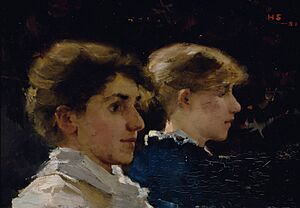
Her first painting shown at a major art exhibition, called Reflection, was painted in Brittany. It was displayed in 1885 at the Royal Academy of Arts in London. Her art was also shown at other important galleries like the Grosvenor Gallery and the New Gallery. After she married Adrian Scott Stokes in 1884, she started using the name 'Mrs. Adrian Stokes'.
In the summers of 1885 and 1886, Marianne and her husband visited Skagen in northern Denmark. This place was home to an artists' community known as the Skagen Painters. The Stokeses became close friends with artists Michael and Anna Ancher there. They also visited Ireland in the summer of 1885.
Marianne Stokes's artwork was featured at the Palace of Fine Arts during the 1893 World's Columbian Exposition in Chicago, Illinois. This was a huge world's fair.

In 1900, she had a joint art show with her husband at the Fine Art Society. The Stokeses lived in St Ives, a town where Marianne was part of the Newlyn School, a group of artists. Since they didn't have children, they often traveled abroad. They frequently visited Tyrol and, in 1905, went to Hungary and the High Tatra mountains. They spent about six months there, sketching and painting in villages like Važec, Mengusovce, and Ždiar. Adrian focused on landscapes, while Marianne painted portraits. Her portraits showed amazing detail in the traditional clothes worn by the Slovak people. These paintings are a valuable record of their culture.
Marianne Stokes later stopped using oil paints. She was inspired by the Pre-Raphaelite art movement and the translation work of Christiana Herringham. She started creating flat paintings using tempera and gesso. Her artworks looked like frescoes (paintings on plaster walls). She was also an Associate of the Royal Society of Painters in Water Colours. In 2018, her work was part of an art show called Women in Paris 1850-1900.
Marianne Stokes passed away in 1927, and Adrian Stokes died in 1935. They were both buried at Mortlake Roman Catholic Cemetery in London.
Her Amazing Artworks
Images for kids
See also
 In Spanish: Marianne Stokes para niños
In Spanish: Marianne Stokes para niños


